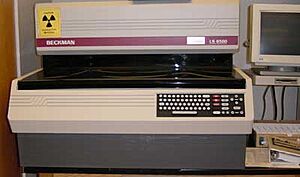Liquid scintillation counting facts for kids
Liquid scintillation counting is a clever scientific method. It helps scientists find and measure tiny bits of energy called radiation. This energy comes from special atoms called nuclides, especially those that give off beta or alpha particles. It can also spot other tiny particles like Auger electrons from certain elements such as Chromium-51 (51Cr) and Iodine-125 (125I).
Contents
How Does This Counting Work?
To measure radiation, the samples are mixed into a special liquid called a "cocktail." This cocktail is made of a scented liquid and tiny amounts of other helpful ingredients called "fluors."
What Happens in the Cocktail?
When beta or alpha particles from the sample hit the cocktail, they transfer their energy to the liquid's molecules. These molecules then pass the energy to the fluors. When the fluors get this energy, they get excited and then release the energy by giving off light.
Making the Light Easier to See
Sometimes, the cocktail has extra ingredients that change the color of the light. This makes the light easier for the machine to detect and measure.
The Liquid Scintillation Counter Machine
The samples, now mixed in their cocktails, are placed in small, clear containers. These are often made of glass or plastic. These containers are then put into a machine called a liquid scintillation counter.
How the Machine Detects Light
The counter has two special light detectors called photomultiplier tubes. These tubes work together to make sure that only real flashes of light are counted. This helps the machine get accurate results.
How Well Does It Count?
The machine's ability to count radiation depends on the type of atom. For example, it can count almost 100% of the radiation from phosphorus-32 (32P), which gives off a lot of energy. But for tritium, which gives off less energy, it might only count about 30%.
What Can Go Wrong?
Sometimes, certain chemicals or very colorful samples can make it harder for the machine to count correctly. This problem is called "quenching." Scientists can fix this by preparing the samples very carefully or by correcting the data later.
Counting Without a Cocktail
There's another way to count phosphorus-32 (32P) without using the cocktail. This method is called Cherenkov counting. It works because phosphorus-32 gives off a special type of light called Cherenkov radiation. The photomultiplier tubes can detect this light directly. Cherenkov counting is usually used for quick, rough measurements.


